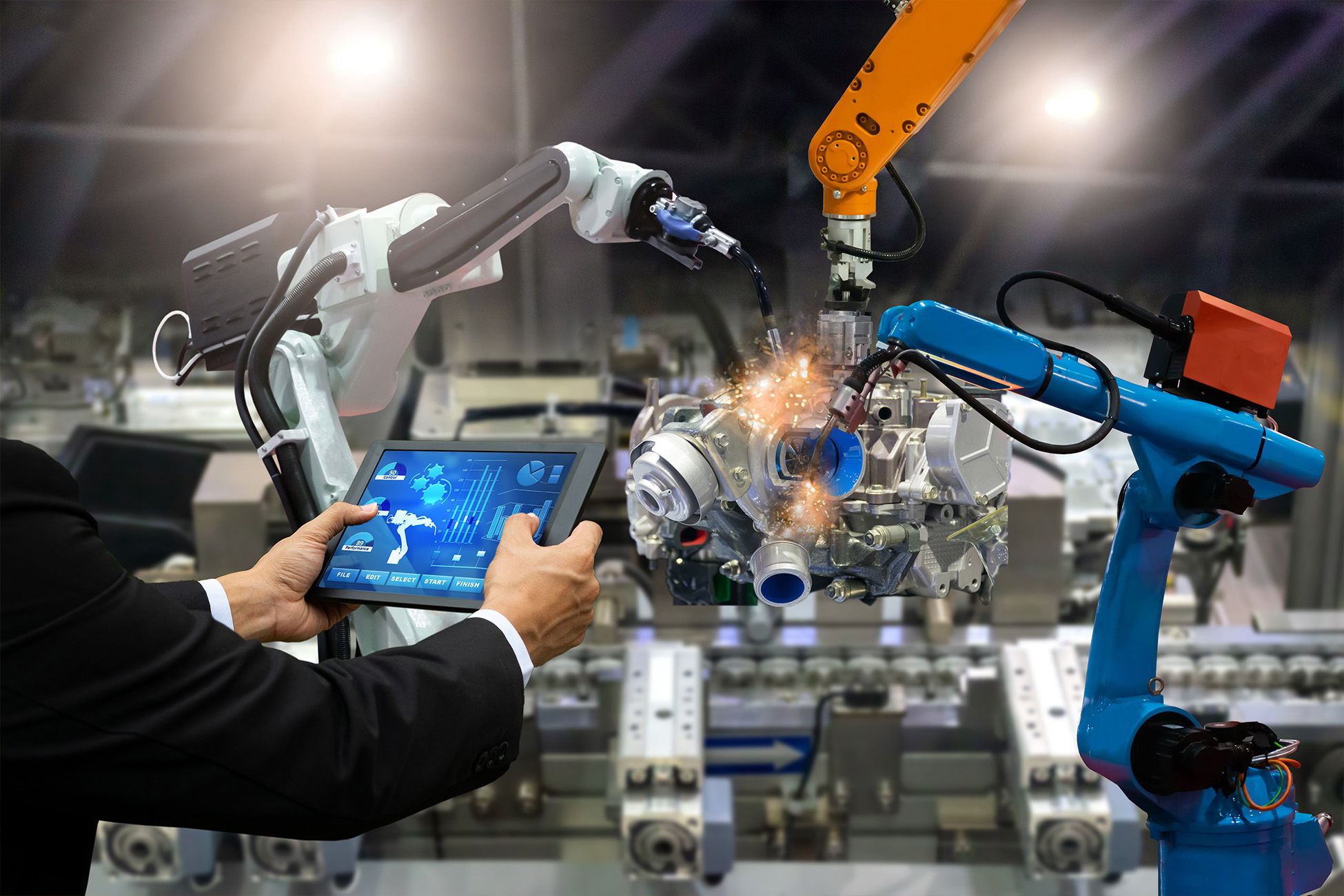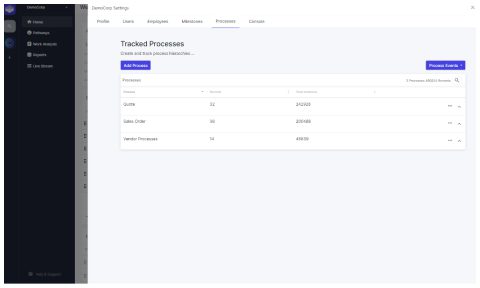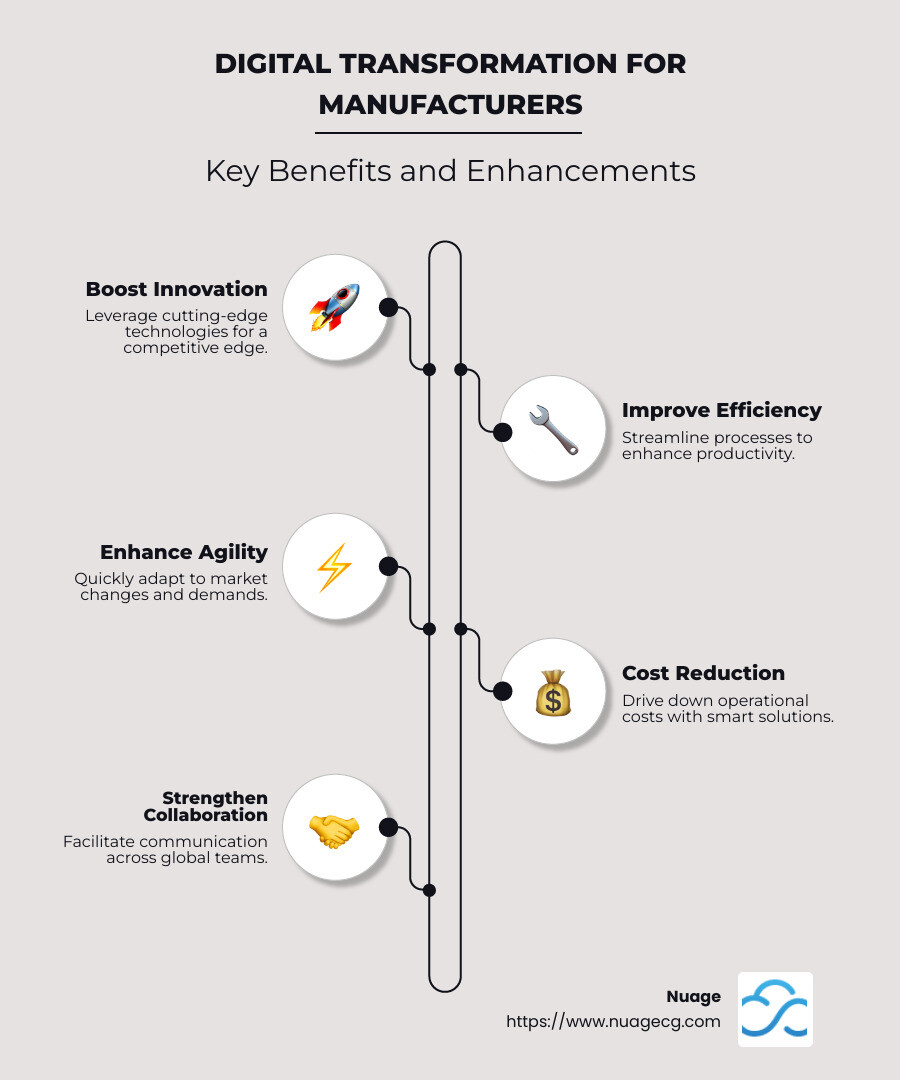
Digital change for manufacturers has become a crucial turning point in the industry, enabling companies to steer the ever-changing landscape of technology and market demands. For those seeking immediate answers, here’s a quick snapshot:
- Boost Innovation: Gain competitive edges with cutting-edge technology.
- Improve Efficiency: Streamline processes for better productivity.
- Improve Agility: Quickly adapt to market changes and demands.
- Cost Reduction: Drive down operational costs with smart solutions.
- Strengthen Collaboration: Facilitate communication across global teams.
In today’s market, manufacturers recognize the necessity to shift from analog processes to digital systems. This change is essential not just to keep up with trends but to thrive amid volatility and unpredictabilities. By embracing digitalization, manufacturers open up new avenues for operational excellence, innovation, and agility. As highlighted by IFS and NetSuite, this progression is not merely about updating technology but about reshaping entire business models to seize future growth opportunities.
My name is Louis Balla, and I have over 15 years of experience in guiding companies through digital change for manufacturers. My work with ERP solutions like IFS and NetSuite focuses on streamlining processes and driving growth. Join me as we explore the steps to successfully start on a digital change journey.
Understanding Digital Change for Manufacturers
Digital change is reshaping the manufacturing landscape, driving companies to rethink how they operate. At its core, this change involves integrating technology into every aspect of manufacturing processes, from production lines to supply chain management. But what does this mean for manufacturers?
The Shift from Manual to Digital
In the past, manufacturing relied heavily on manual processes. These included paper-based tracking systems and physical labor. Today, with the advent of digital technologies, manufacturers can automate many of these tasks. This shift not only improves efficiency but also reduces errors and costs.
For example, Bedford Industries quickly adapted by launching an ecommerce site to meet the rising demand for their new products like face shields. This digital pivot allowed them to reach new customers while better serving existing ones.
Integrating Technology into Manufacturing
Technology integration is key to successful digital change. By embedding digital tools into manufacturing processes, companies can optimize operations and improve productivity.
Consider the role of Enterprise Resource Planning (ERP) systems like NetSuite and IFS. These systems offer a unified platform to manage everything from inventory to customer relations. This integration facilitates real-time data access, enabling manufacturers to make informed decisions quickly.
- Automation and Robotics: These technologies streamline repetitive tasks, freeing up human resources for more strategic roles.
- Cloud Computing: Offers scalable solutions that ensure data accessibility and security across global teams.
- AI and Machine Learning: Improve decision-making by providing insights from data patterns and trends.
Embracing the New Normal
The current market demands agility. Manufacturers must be ready to pivot quickly in response to changes. As Jim Estill, CEO of Danby Appliances, notes, “Channels are changing, and it’s about pivoting channels.” This means manufacturers need flexible systems that can adapt to new sales channels and consumer preferences.
To stay competitive, manufacturers should focus on:
- Ecommerce Solutions: As seen with Bedford Industries, an online presence is crucial for reaching broader markets.
- Supply Chain Visibility: Digitizing supply chains improves resilience and allows for better crisis management.
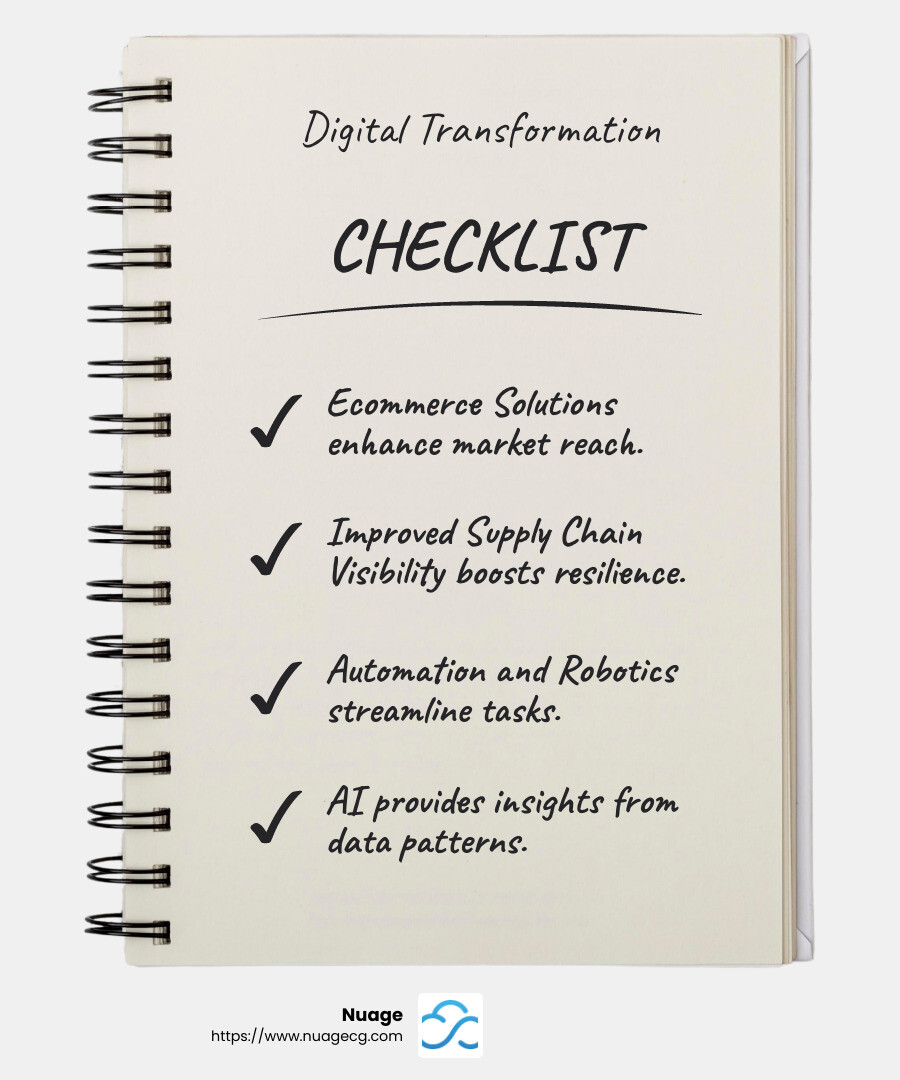
Digital change for manufacturers is not just a technological upgrade. It’s a strategic shift that requires embracing new tools and mindsets. By understanding and implementing digital change, manufacturers can position themselves for future success.
Next, we’ll dig into the Key Benefits of Digital Change, exploring how these changes lead to efficiency, cost reduction, and innovation.
Key Benefits of Digital Change
Digital change for manufacturers is more than just a buzzword—it’s a game-changer. Let’s explore how this shift can significantly benefit the manufacturing industry by enhancing efficiency, reducing costs, and fostering innovation.
Efficiency: Streamlining Operations
Digital change brings a host of efficiency improvements. By automating routine tasks, manufacturers can ensure faster production times and higher output with less manual intervention. This means:
- Reduced Human Error: Automated systems ensure consistent quality and minimize mistakes.
- Faster Production Cycles: Technologies like robotics and AI accelerate processes, enabling quicker turnaround times.
- Real-Time Monitoring: Tools like IoT sensors provide instant feedback, allowing for immediate adjustments to improve performance.
For more insights on how digital tools can enhance efficiency, explore our IFS Cloud solutions.
Cost Reduction: Saving Resources
One of the most compelling benefits of digital change is cost reduction. By leveraging digital tools, manufacturers can cut down on unnecessary expenses in several ways:
- Energy Savings: Smart systems optimize energy usage, reducing utility bills.
- Minimized Waste: With precise production techniques, materials are used more efficiently, decreasing waste.
- Optimized Inventory: Systems like NetSuite help manage stock levels, preventing overproduction and excess inventory costs.
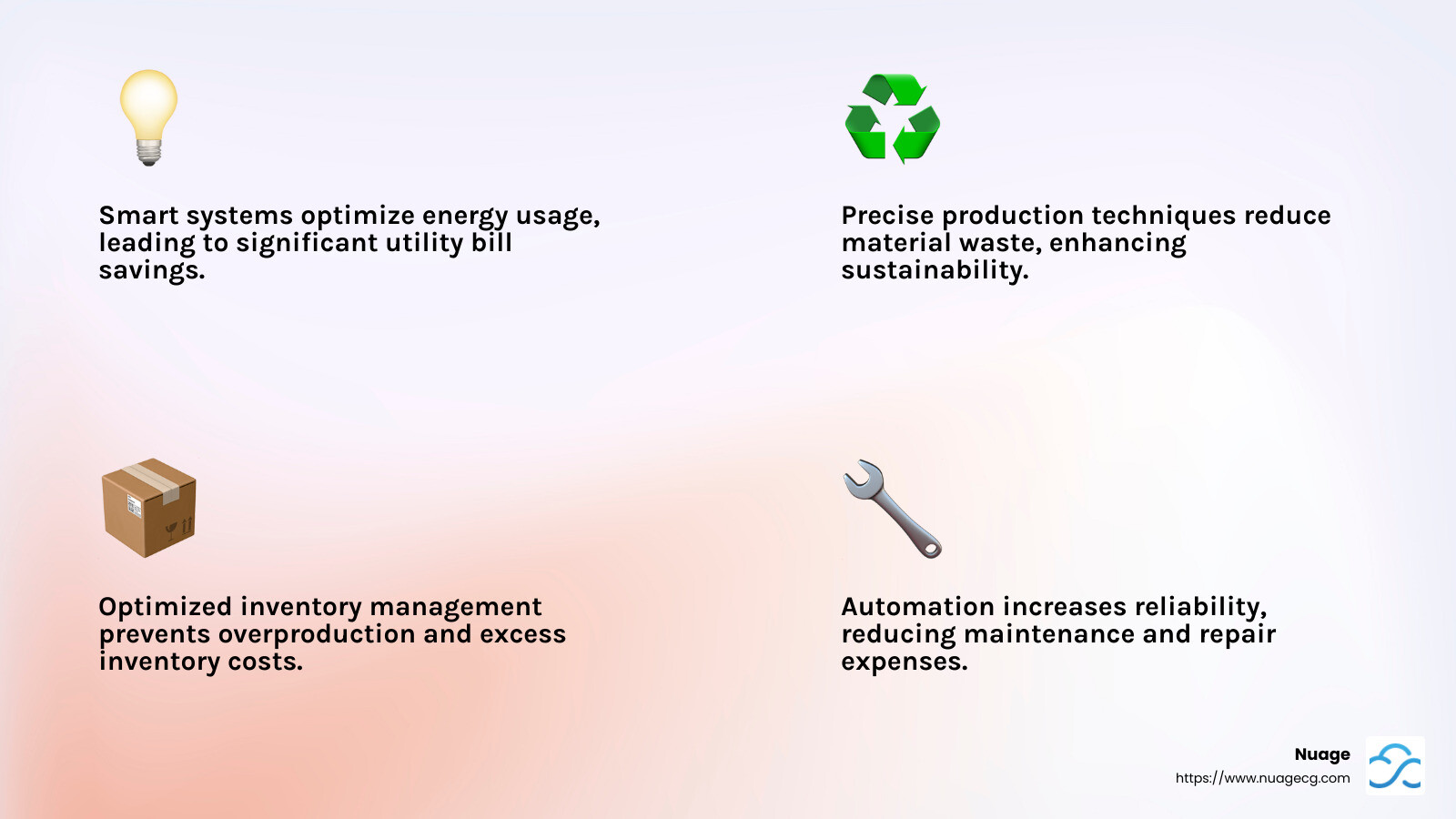
Innovation: Driving New Opportunities
Digital change opens the door to innovation, allowing manufacturers to explore new business models and product offerings:
- Product Customization: Digital tools enable personalized products custom to customer preferences.
- New Revenue Streams: Offering services like maintenance subscriptions can create recurring revenue, as highlighted in the NetSuite guide.
- Improved R&D: Access to vast amounts of data allows for better research and development, leading to innovative product designs and features.
Consider how companies like those in the IFS research report have accepted digital change. By integrating technology, they not only improved their existing processes but also explored new avenues for growth and innovation.
In summary, the key benefits of digital change—efficiency, cost reduction, and innovation—are driving manufacturers to accept this change. Next, we’ll look at the Steps to Implement Digital Change, guiding you through the process of assessing, strategizing, and executing your digital initiatives.
Steps to Implement Digital Change
Starting on a digital change for manufacturers can seem daunting, but breaking it down into manageable steps makes it achievable. Let’s explore how to effectively assess, strategize, and execute this change.
Assessment: Laying the Foundation
Before diving into digital change, it’s crucial to assess your current state. This involves understanding where your manufacturing operations stand and identifying areas ripe for improvement.
- Readiness Analysis: Evaluate your existing technology and processes. Are they ready for digital integration? Identify opportunities and potential risks.
- Role Assessment: Examine your workforce. Are there skill gaps that need addressing? This helps in planning for training and role adjustments.
- Value Assessment: Understand the potential financial impact of digital change. What cost savings and revenue growth can you anticipate?
These assessments help set the stage for a successful change by providing a clear picture of where you are and where you need to go.
Strategy: Crafting Your Roadmap
With a solid understanding of your current state, the next step is to develop a strategic plan. This plan acts as a roadmap, guiding your digital change journey.
- Define Goals and KPIs: Clearly outline what you aim to achieve. What are your key performance indicators (KPIs)? This could include faster production times or reduced waste.
- Engage Stakeholders: Involve leadership and key team members in the planning process. Their buy-in is critical for successful implementation.
- Align with Enterprise Architecture: Ensure your digital strategy aligns with your existing systems and processes. This avoids conflicts and maximizes integration.
A well-crafted strategy ensures that your digital change is focused and aligned with your business objectives.
Execution: Bringing Plans to Life
Once your strategy is in place, it’s time to execute. This phase involves implementing the changes and ensuring they deliver the expected benefits.
- Scope Management: Keep the project scope well-defined and controlled. Unchecked scope can derail projects, as shown in best practices from IFS.
- Data Migration: Transfer your data to new systems carefully. Clean, mapped data ensures smooth transitions and effective use of new technologies.
- Training and Enablement: Equip your team with the knowledge and skills needed to thrive in a digital environment. Comprehensive training is key to opening up the benefits of systems like NetSuite.
Execution is not just about going live with new technology. It’s about ensuring that these changes lead to tangible improvements in your manufacturing processes.
Continuous Improvement
Digital change is an ongoing journey. Post-implementation, focus on continuous improvement to maximize the value of your digital initiatives. Regularly revisit your strategies, assess their effectiveness, and adjust as necessary.
By following these steps—assessment, strategy, and execution—you can steer the path to digital change with confidence. Next, we’ll dig into Digital Change for Manufacturers: Best Practices, offering insights into data management, employee training, and continuous improvement.
Digital Change for Manufacturers: Best Practices
When it comes to digital change for manufacturers, adopting best practices is key to success. Let’s explore how data management, employee training, and continuous improvement can drive effective change.
Data Management
Data is the backbone of digital change. Proper management ensures accuracy, reliability, and accessibility.
-
Data Quality: Before migrating data, ensure it’s clean and accurate. This prevents operational inefficiencies and incorrect reporting. Techniques like data cleansing and validation are crucial. For more on this, check out NetSuite’s data migration practices.
-
Data Governance: Establish policies to maintain data quality over time. Consistent data definitions and formats are essential. This governance ensures your data remains a valuable asset.
-
Data Integrity: During migration, safeguard data integrity. Any loss or corruption can impact operations. Follow best practices to maintain data reliability.
Employee Training
Your workforce is central to digital change. Well-trained employees are more efficient and adaptable to new technologies.
-
Engage Employees: Involve them in the change process. Their insights can reduce waste and improve processes. For instance, engaging workers in material use can improve efficiency and environmental responsibility.
-
Comprehensive Training: Equip your team with the skills needed for new systems. Training ensures they can fully use technologies like IFS Cloud.
-
Motivation: Encourage employees by highlighting the benefits of digital change. This can lead to increased job satisfaction and productivity.
Continuous Improvement
Digital change is not a one-time event. It requires ongoing efforts to stay relevant and competitive.
-
Regular Benchmarking: Use KPIs to evaluate performance. Regularly review these metrics to catch and address issues early. This proactive approach prevents major disruptions.
-
Iterative Process: Adopt a mindset of continuous improvement. As Compac’s Hart noted, “We’re going to move from problem to process, not from problem to solution.” This approach fosters long-term success.
-
Adaptability: Be ready to adjust strategies as needed. The business environment is dynamic, and flexibility is key to thriving in it.
By focusing on these best practices—data management, employee training, and continuous improvement—manufacturers can harness the full potential of digital change. Up next, we’ll explore the Top Technologies Driving Digital Change, including IoT, AI, and cloud computing.
Top Technologies Driving Digital Change
In the field of digital change for manufacturers, certain technologies stand out as key drivers. Let’s explore how IoT, AI, and cloud computing are reshaping the manufacturing landscape.
Internet of Things (IoT)
The IoT revolution is making waves in manufacturing by connecting devices and systems for seamless operations.
-
Real-Time Monitoring: IoT sensors on equipment allow manufacturers to monitor performance in real time. This capability helps predict maintenance needs, reducing downtime and saving costs. For instance, ERP systems integrated with IoT can alert managers before a machine breaks down, ensuring smooth operations.
-
Improved Efficiency: By automating data collection, IoT reduces manual data entry errors. This leads to more accurate insights and better decision-making. The integration of IoT with ERP systems is crucial for optimizing inventory and delivery processes, as highlighted in NetSuite’s ERP solutions.
Artificial Intelligence (AI)
AI is not just a buzzword; it’s changing manufacturing by offering smarter insights and automating complex tasks.
-
Predictive Analytics: AI processes vast amounts of data to forecast trends and outcomes. This helps manufacturers anticipate demand and optimize production schedules.
-
Personalization and Automation: AI-driven systems can automate routine tasks and personalize customer interactions. This frees up human resources for more strategic roles. As noted, AI capabilities are becoming standard in ERP systems, enhancing their value to manufacturers.
-
Generative AI: This advanced AI technology is pushing boundaries by creating new designs and solutions, driving innovation in manufacturing processes.
Cloud Computing
Cloud computing offers manufacturers flexibility, scalability, and collaboration opportunities.
-
Scalable Resources: Manufacturers can scale IT resources up or down based on demand, reducing costs and improving efficiency. Cloud platforms like IFS Cloud provide robust solutions custom for manufacturing needs.
-
Collaboration and Accessibility: Cloud-based systems enable teams to collaborate across locations, accessing critical data anytime, anywhere. This improves productivity and decision-making.
-
Data Security and Recovery: With cloud computing, manufacturers benefit from improved data protection and disaster recovery solutions, ensuring business continuity.
By embracing these technologies, manufacturers can open up new levels of innovation and efficiency. As we explore further, we’ll see how ERP systems play a pivotal role in facilitating digital change, streamlining processes, and leveraging data analytics.
How ERP Systems Facilitate Digital Change
In the journey of digital change for manufacturers, ERP systems stand as pivotal enablers. They streamline operations, automate processes, and provide valuable insights through data analytics. Let’s explore how these systems drive digital change.
Process Automation
ERP systems are the backbone of automation in manufacturing. They automate repetitive tasks, freeing up human resources for more strategic activities.
-
Streamlined Operations: By automating order processing, inventory updates, and payment management, ERP systems reduce manual errors and increase efficiency. This is particularly vital in sectors like logistics, where timely delivery is crucial.
-
Predictive Maintenance: Integrated with IoT, ERP systems can predict equipment maintenance needs. This prevents unexpected breakdowns, as highlighted by IFS Manufacturing Solutions, which offer real-time visibility and operational control.
Data Analytics
Data is at the heart of digital change, and ERP systems harness it effectively.
-
Real-Time Insights: ERP systems collect data from various sources, providing real-time insights into operations. This enables manufacturers to make informed decisions quickly.
-
Improved Decision-Making: With advanced analytics, manufacturers can analyze trends and forecast demand. AI-powered insights, as noted by NetSuite’s ERP solutions, help optimize production schedules and improve customer satisfaction.
-
Customizable Dashboards: Modern ERP systems offer customizable dashboards that display key metrics. This personalization helps manufacturers focus on what matters most to their business.
Integration and Scalability
ERP systems are designed to integrate seamlessly with other technologies, offering scalability as businesses grow.
-
Seamless Integration: ERP systems integrate with ecommerce platforms, IoT devices, and other applications, ensuring a smooth flow of information across the organization.
-
Scalability: As manufacturers expand, ERP systems can scale to accommodate increased data and process complexity. Cloud-based solutions like IFS Cloud offer flexibility and scalability custom to manufacturing needs.
By leveraging ERP systems, manufacturers can drive digital change effectively. These systems not only automate and streamline processes but also provide the data-driven insights necessary for continuous improvement. As we steer further, we’ll tackle common questions about digital change in manufacturing.
Frequently Asked Questions about Digital Change for Manufacturers
What is digital change in manufacturing?
Digital change in manufacturing refers to the shift from traditional manufacturing processes to modern, technology-driven approaches. This change involves integrating digital technologies like IoT, AI, and cloud computing into manufacturing operations. The goal is to improve productivity, enhance product quality, and respond more quickly to market demands.
Digital change is not just about adopting new technologies but also about reshaping business models and processes to create value. For instance, manufacturers are using digital tools to optimize supply chains, automate production lines, and improve customer experiences. According to a report by IFS, digital change offers tremendous potential for businesses, especially in today’s volatile and unpredictable market conditions.
How does digital change impact manufacturing?
Digital change impacts manufacturing in several significant ways:
-
Increased Efficiency: Automation and digital tools streamline processes, reducing the time and resources needed for production. This leads to faster turnaround times and lower operational costs.
-
Improved Decision-Making: With real-time data analytics, manufacturers can make informed decisions quickly. This helps in predicting market trends, optimizing inventory, and enhancing customer satisfaction.
-
Improved Innovation: Digital change fosters innovation by enabling manufacturers to experiment with new designs and production methods. Technologies like 3D printing and AI-driven design tools are paving the way for innovative product development.
-
Sustainability: As noted in a YouTube discussion, sustainability has become a key focus due to regulatory pressures and customer demand. Digital change helps manufacturers adopt sustainable practices by optimizing resource use and reducing waste.
What are the challenges of digital change?
While digital change offers many benefits, it also presents challenges:
-
Cultural Resistance: Employees may resist new technologies due to fear of job loss or the need for new skills. Effective change management and training programs are crucial to overcoming this resistance.
-
Data Security: As manufacturers rely more on digital systems, data security becomes a pressing concern. Protecting sensitive information from cyber threats requires robust cybersecurity measures.
-
Integration Complexities: Integrating new technologies with existing systems can be complex and costly. Ensuring seamless integration requires careful planning and investment in compatible technologies.
-
Cost of Implementation: Initial costs for digital change can be high. However, the long-term benefits often outweigh these costs, as seen in the successful implementation of NetSuite’s ERP solutions, which provide scalable and flexible options for manufacturers.
By addressing these challenges, manufacturers can successfully steer the path of digital change and open up its full potential. We’ll explore more about how these changes are shaping the future of manufacturing.
Conclusion
In today’s rapidly evolving manufacturing landscape, embracing digital change is no longer optional—it’s essential. At Nuage, we understand the complexities and challenges that manufacturers face during this transition. With over 20 years of experience in the ERP industry, we are uniquely positioned to guide your business through this transformative journey.
Our expertise lies in providing custom ERP solutions that cater specifically to the manufacturing sector. By partnering with industry leaders like NetSuite and IFS Cloud, we ensure that your business has access to the most advanced technologies available. These partnerships allow us to offer solutions that are not just about implementing software but about driving real change—improving efficiency, reducing costs, and fostering innovation.
We believe in empowering our clients. This means delivering solutions that are easy to update and integrate, ensuring you always have the latest capabilities without the hassle of complex upgrades. Our approach is not just to sell software but to provide comprehensive support that includes:
- Change Management: Assisting your team in adapting to new technologies with minimal disruption.
- Continuous Improvement: Offering ongoing support to ensure your systems evolve with your business needs.
- Data-Driven Insights: Leveraging ERP systems to provide real-time analytics, enhancing decision-making and strategic planning.
The journey from analog to digital can be daunting, but with the right partner, it becomes a pathway to growth and success. At Nuage, we are committed to being that partner—helping you steer the complexities of digital change and ensuring your business thrives in the digital age.
For more information on how we can support your digital change journey, visit our NetSuite page. Let’s work together to open up the full potential of your manufacturing operations.
